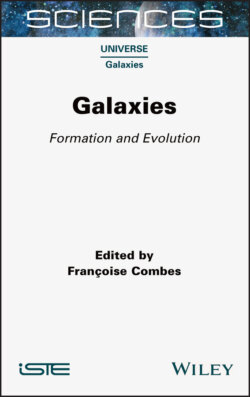Galaxies

Реклама. ООО «ЛитРес», ИНН: 7719571260.
Оглавление
Группа авторов. Galaxies
Table of Contents
List of Illustrations
List of Tables
Guide
Pages
Galaxies. Formation and Evolution
Introduction
1. The Classification of Galaxies
1.1. Introduction
1.2. Classes of galaxies
1.3. Elliptical galaxies
1.4. Spiral galaxies
1.5. S0 galaxies
1.6. Magellanic spiral and irregular galaxies
1.7. Dwarf elliptical, S0, and spheroidal galaxies
1.8. Edge-on galaxies
1.9. Morphology of interacting and merging galaxies
1.10. General properties along the CVRHS sequence. 1.10.1. Morphological systematics
1.10.2. Astrophysical systematics
1.11. Other approaches to galaxy classification
1.12. Interpretations of morphology
1.13. Artificial galaxies and the future of galaxy classification
1.14. References
2. Our Galaxy, the Milky Way
2.1. Introduction
2.2. Baryonic discs and their spiral structure
2.2.1. Neutral, ionized and molecular gas
2.2.2. Thin and thick stellar discs
2.2.3. Spiral structure from gaseous and stellar tracers
2.3. The central kiloparsecs: the bar and the bulge
2.4. The stellar halo
2.5. On the dark matter content and shape, as inferred from rotation curves and stellar streams
2.6. Dissecting the global structure: stellar kinematics, abundances and ages
2.6.1. Setting the scene: the solar vicinity
2.6.2. Zooming out on a several kpc scale. 2.6.2.1. Chemical structure of the Galactic disc
2.6.2.2. Evidence of the last significant merger experienced by the Milky Way
2.6.3. Digging into the bulge
2.7. Reconstructing the Milky Way evolution
2.8. Perspectives
2.9. References
3. Early-type Galaxies
3.1. Introduction
3.2. General properties: components and morphology
3.2.1. Discs and bars
3.2.2. Gas and dust content
3.2.3. Dark matter and halo
3.2.4. Globular clusters
3.2.5. Light and mass profiles
3.2.6. Extreme cases: brightest cluster galaxies and ultra-diffuse galaxies
3.3. Zoom on the stellar component
3.3.1. Scaling relations: Faber–Jackson, fundamental plane and virial plane
3.3.2. Age and metallicity
3.3.2.1. Integrated values
3.3.2.2. Gradients
3.3.3. Initial mass function
3.4. Dynamics of ETGs
3.4.1. Observations
3.4.2. Toward a kinematic classification of ETGs
3.4.3. Modeling
3.4.4. Supermassive black holes
3.5. Formation and evolution processes
3.5.1. Perspective atz = 0: the mass–radius plane
3.5.2. Growth, mergers and transformations
3.5.3. Ex situ versus in situ
3.5.4. Environment
3.6. Conclusion
3.7. References
4. Spiral Galaxies
4.1. Introduction
4.2. Blue and red galaxies: quenching star formation. 4.2.1. Definition of bimodality
4.2.2. The parameters that determine the red sequence
4.2.3. Mechanisms for quenching star formation
4.3. Spiral galaxies: density waves or not? 4.3.1. The winding problem
4.3.2. The theory of density waves
4.3.3. Role of gas and star formation
4.4. Bars: drivers of evolution
4.4.1. Formation of bars
4.4.2. Orbits in a barred galaxy
4.4.3. Response of gas to a barred potential
4.4.4. Vertical resonances and peanuts
4.4.5. Dark matter and bars
4.5. Environment of spiral galaxies. 4.5.1. Morphological segregation
4.5.2. The problem of bulgeless galaxies
4.6. Conclusion
4.7. References
5. Galaxy Mergers and Interactions through Cosmic Time
5.1. Introduction
5.2. The physics of merging
5.3. The merger history of galaxies. 5.3.1. Defining mergers and merging
5.3.2. Merger rates in the nearby universe
5.3.3. Galaxy merger fraction evolution toz = 6
5.3.4. Galaxy merger rates
5.4. The added value of mergers. 5.4.1. Galaxy and black hole assembly through interactions and mergers
5.4.2. Cosmological relevance
5.4.3. Future uses and methods
5.5. Summary
5.6. Acknowledgments
5.7. References
6. Cosmic Evolution of Galaxies
6.1. Introduction
6.2. Characteristics of galaxies used to define their cosmic evolution. 6.2.1. Decoding multi-wavelength radiation
6.2.1.1. Visible domain
6.2.1.2. Infrared and submillimeter domain
6.2.1.3. Other wavelength domains
6.2.1.4. The special case of active galaxy nuclei
6.2.1.5. Estimation of physical parameters
6.2.2. Populations of galaxies. 6.2.2.1. Blue galaxies and red galaxies
6.2.2.2. Luminosity function
6.3. Starbursts, secular evolution and universality of star formation
6.3.1. Definition of a starburst
6.3.2. The SFMS and the secular evolution of galaxies
6.3.3. Origin of starbursts
6.3.4. Secular evolution and the influence of the galactic environment
6.4. Detection of distant galaxies
6.4.1. Deep surveys of the Universe
6.4.2. Large samples of distant galaxies. 6.4.2.1. Lyman break technique
6.4.2.2. So-called “color–color” methods and photometric redshifts
6.4.2.3. Multi-wavelength approaches
6.4.3. K correction
6.5. Cosmic history of galaxies. 6.5.1. History of star formation
6.5.2. Evolution of the stellar mass function and formation of the red galaxy sequence
6.5.3. Evolution of the metallicity and of the average size of galaxies
6.5.4. Evolution of the galaxy merger and starburst rates
6.6. Origin of the cosmic history of galaxies
6.6.1. The diffuse cosmic background as a signature of the cosmic history of galaxies
6.6.2. Unraveling the origin of the cosmic history of galaxies by studying their reservoirs of interstellar matter
6.7. Conclusion
6.8. References
List of Authors
Author Biographies
Index. A
B
C
D
E
F, G, H
I, J, L
M
P
Q, R
S
T
V, W
WILEY END USER LICENSE AGREEMENT
Отрывок из книги
Universe, Field Director – Fabienne Casoli
.....
Athanassoula, E., Rodonov, S.A., Peschke, N., et al. (2016). ApJ, 821, 90.
Baillard, A., Bertin, E., de Lapparent, V., et al. (2011). A&A, 532, 74.
.....